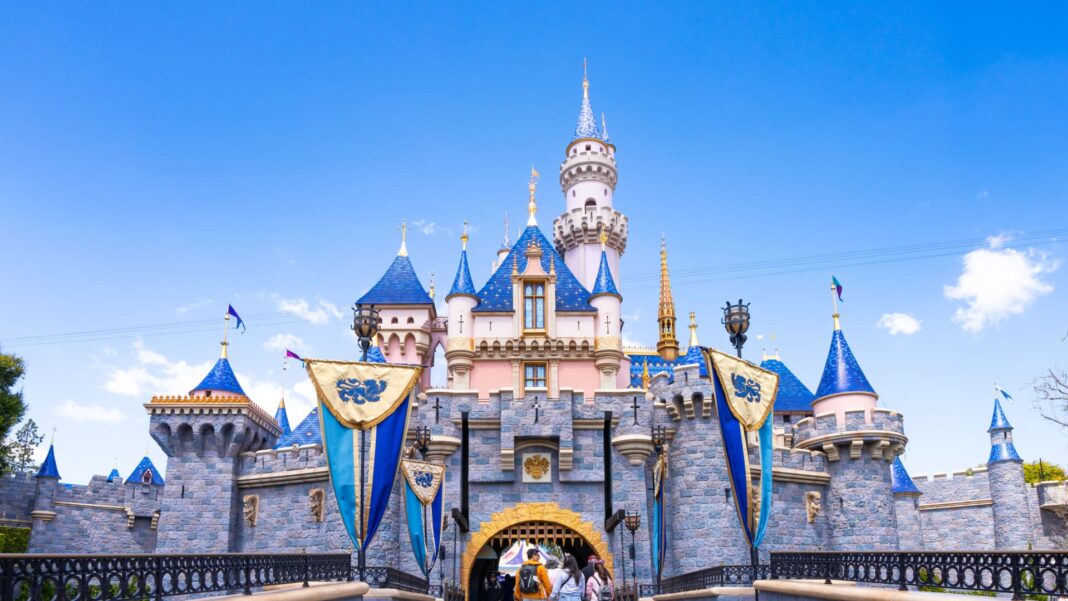General views of Sleeping Beauty Castle at Disneyland on April 06, 2024 in Anaheim, California.
Aaronp/bauer-griffin | Gc Images | Getty Images
The “Happiest Place on Earth” turns 70 this week.
Disneyland, a pillar of the Anaheim, California, community since 1955, was a passion project of founder Walt Disney, a place where adults and their children could have fun together. It also served as a place where the longtime media company could show off and weave together different pieces of its business from films, television shows and comic strips to music and merchandising.
Disney’s portfolio of intellectual property has been the bedrock of its theme parks since the very first location opened its doors. These days, the company’s experiences division, which includes parks, resorts, cruises and consumer products, remains one of its best profit drivers. Operating income for the unit for fiscal 2024 was more than double that of the content-centric entertainment division, where the IP originates.
Disneyland in Anaheim began with more than a dozen attractions, many of which were pulled directly from Disney’s archive of theatrical films. Among them were Mad Tea Party based on “Alice in Wonderland,” Mr. Toad’s Wild Ride from “The Adventures of Ichabod and Mr. Toad,” Peter Pan’s Flight, Snow White’s Enchanted Wish and Dumbo the Flying Elephant.
Over the past seven decades, Disney has opened a total of 12 theme parks across the United States, Europe and Asia, with another set to open in Abu Dhabi, United Arab Emirates, in the coming years. It also has a fleet of cruise ships, which is set to double by 2031, and nearly 60 resort hotels and vacation properties globally.
“If you go back now 70 years ago, Walt knew the great stories that he was creating, if he combined those with the technologies that were at hand at the time with this idea of an immersive experience that he could create something that no one else had ever done,” said Josh D’Amaro, chairman of Walt Disney’s parks and resorts. “And it really set the Disney brand apart.”
Vice president Richard M Nixon, Mrs. Patricia Nixon, Tricia Nixon, 9 years, Julie Nixon, 7 years, Donnie Nixon (nephew), Fess Parker (actor), CV Wood, Junior (General manager of Disneyland), Anaheim, California, August 11, 1955.
University Of Southern California | Corbis Historical | Getty Images
The first rides at Disneyland were interspersed with original creations like Jungle Cruise, Autopia and the Disneyland Railroad.
While Disney would bring a number of non-IP attractions to life over the next few decades — Matterhorn Bobsleds, Pirates of the Caribbean, Haunted Mansion, Big Thunder Mountain and Space Mountain, among them — in the last decade, the company has committed to utilizing its existing catalog of stories to fuel new and updated attractions in its domestic and international theme parks.
Collecting stories
Much of that strategy has come in the wake of CEO Bob Iger’s acquisition of four major studios — Pixar (2006), Marvel (2009), Lucasfilm (2012) and 20th Century Fox (2019) — which brought coveted franchises under the House of Mouse roof.
“I think we’ve been fortunate now in that we have gone after that IP, brought it into the Disney fold, and just made the brand even more powerful,” D’Amaro said.
Many of these brands already appeared in the company’s parks as part of licensing deals, like Star Tours, which opened in 1987; Indiana Jones Adventure, added in 1995; and Buzz Lightyear Astro Blaster, which debuted in 2005.
The company also opened entire lands — curated areas that have themed rides, food and entertainment centered on one piece of IP. This included A Bug’s Land, which opened in 2002 at Disney’s California Adventure park, based on Pixar’s “A Bug’s Life” and Pandora — The World of Avatar, set on the fictional planet Pandora from Fox’s “Avatar” film and built at Animal Kingdom in Florida.
General views the Pandora The World Of Avatar Dedication at the Disney Animal Kingdom on May 23, 2017 in Orlando, Florida.
Gustavo Caballero | Getty Images Entertainment | Getty Images
Many of these additions came under the leadership of then-CEO Michael Eisner, who helmed the company from 1984 until 2005.
Chief among his acquisitions was securing the IP for Star Wars and Indiana Jones — two of the biggest franchises of the time — according to Gavin Doyle, founder of MickeyVisit.com. Eisner “went and licensed it and brought it into the parks,” Doyle said.
Attendees sit in the Millennium Falcon: Smugglers Run ride following the unveiling of Star Wars: Galaxy’s Edge at Walt Disney Co.’s Disneyland theme park in Anaheim, California, U.S., on Wednesday, May 29, 2019.
Bloomberg | Getty Images
Decades later, Disney acquired Lucasfilm, which owns both film franchises, and expanded their presence.
In 2019, the company opened two identical Star Wars-themed lands, one in Florida at Hollywood Studios and one in California at Disneyland. A new Indiana Jones attraction is planned for Disney’s Animal Kingdom as part of the park’s new Tropical Americas area. It is set to open in 2027.
Fueling Disney parks with IP
Last year, revenue growth in Disney’s experiences division was the strongest of any Disney division.
Experiences posted record revenue and profit for fiscal 2024, with revenue rising 5% for the full year to $34.15 billion and operating income up 4% to $9.27 billion.
Heading into 2025, the company said it expected to see 6% to 8% profit growth for experiences in fiscal 2025 — and that’s before it breaks ground on a slew of planned land expansions, new rides and re-themed attractions.
“While investor focus understandably remains on near-term attendance and consumer spending trends, renewed momentum in creating successful content with Disney’s premium IP play a crucial role in generating long-term earnings power across parks, Disney+ and accelerating the unique advantage of the Disney flywheel across its portfolio,” said Robert Fishman, analyst at MoffettNathanson.
Disney is relying heavily on IP as part of its 2023 pledge to invest $60 billion in experiences over the next decade.
On the docket is a new villains land coming to Magic Kingdom, a “Monsters Inc.” land at Hollywood Studios, an “Encanto” ride at Animal Kingdom and the expansion of Avengers Campus with two new attractions. Disneyland is also expected to open a new Avatar area inspired by the scenery in the upcoming “Avatar: Fire and Ash.”
Of course, these new developments also come with some drawbacks. Fan-favorite rides and even whole lands have shuttered or been re-themed as a result.
Anaheim’s A Bug’s Land closed in 2018 so the space could be used to build Avengers Campus, a Marvel-themed land. DinoLand at Animal Kingdom is disappearing to make space for the new Tropical Americas area. At Magic Kingdom, Rivers of America, Tom Sawyer Island and the Liberty Square Riverboat have shut down to make room for an area called Piston Peak — a second Cars-themed land modeled after America’s natural parks.
For individual rides, the most recent change was the re-theming of Splash Mountain at both Disneyland and Walt Disney World. It was refreshed as Tiana’s Bayou Adventure, based on the characters from “The Princess and the Frog.”
People pass by while riding in the Tiana’s Bayou Adventure log flume thrill ride at the Magic Kingdom Park at Walt Disney World on April 3, 2025, in Orlando, Florida.
Gary Hershorn | Corbis News | Getty Images
While some Disney parks fans have balked at the changes the company has made to the parks, the strategy has expanded the company’s fan base and driven revenue growth across its global footprint.
“It’s interesting because the IP is not always for the most vocal theme park fan,” Doyle said. “By definition, the IP is meant to broaden the audience.”
“The whole company’s premised on entertaining, great storytelling,” D’Amaro said. “And in all of our stories, whether they be in animation or through our traditional characters or Star Wars or Marvel or Pixar, there’s this sense of connection to these characters. There’s this emotion that’s created, and then we carry that through into the theme parks.”


